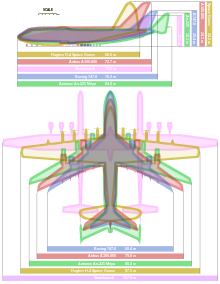Giant plane
Giant aircraft was the designation for several German aircraft designs (e.g. AEG RI , Zeppelin (Staaken) R.VI , Siemens-Schuckert R types , Linke-Hofmann RI and R.II as well as the DFW-R types and the Schütte -Lanz RI ), which were executed during the First World War . The term later expanded through further international projects. These giant aircraft also included the RS types from Dornier (RS = giant seaplane).
The always multi-engine aircraft with a relatively large crew had wingspans of up to 50 m as early as 1918 . Later, the so-called flying boats were the largest types of aircraft. Flying boats are aircraft, while airships are aircraft with aerostatic lift.
Comparison of the size of the giant aircraft
The heaviest and longest aircraft built to date is the Antonov An-225 , while the Scaled Composites Stratolaunch has the largest wingspan. The tallest aircraft ever built is the Hughes H-4 'Spruce Goose' , which however never performed a free flight outside of the ground effect ; their airworthiness is therefore still in doubt today.

See also
- Large aircraft of this time: commercial aircraft , flying boat , commercial airship
- Today's large aircraft: Antonov An-225 , Airbus A380 , Boeing 747
literature
- Robert Curley: War at Sea and in the Air . Britannica Educational Publishing, London 2012, ISBN 9781615307531 , pp. 105 & 106.
- Ludwig Bölkow: A century of aircraft: history and technology of flight . Springer-Verlag, Berlin / Heidelberg 2013, ISBN 9783642957758 , pp. 27, 100 - 104, 129.
Individual evidence
- ↑ a b Giant aircraft of the Zeppelin works in Berlin-Staaken near Spandau , filmothek.bundesarchiv.de
- ↑ a b Jean Roeder: Bomb planes and reconnaissance planes: development history, equipment, armament and use of the German bomb and reconnaissance planes in an international comparison from the beginnings to the unmasking of the Luftwaffe (= Die deutsche Luftfahrt: book series on the development history of German aviation technology , Volume 16 ). Bernard & Graefe, Koblenz 1990, ISBN 9783763752959 , p. 85.
- ↑ Philipp Hassinge: Between Evolution and Revolution - The Change of Materials in Aircraft Construction (= technology discourses: Karlsruhe studies on the history of technology ). KIT Scientific Publishing, 2013, p. 153 [1]
- ↑ Sebastian Knurrhahn: A man must have seen: 50 legendary places - from the monastic republic of Athos to the nuclear bunker in South Dakota , Riva Verlag, Munich 2017, ISBN 9783959717403 , p. 55.
